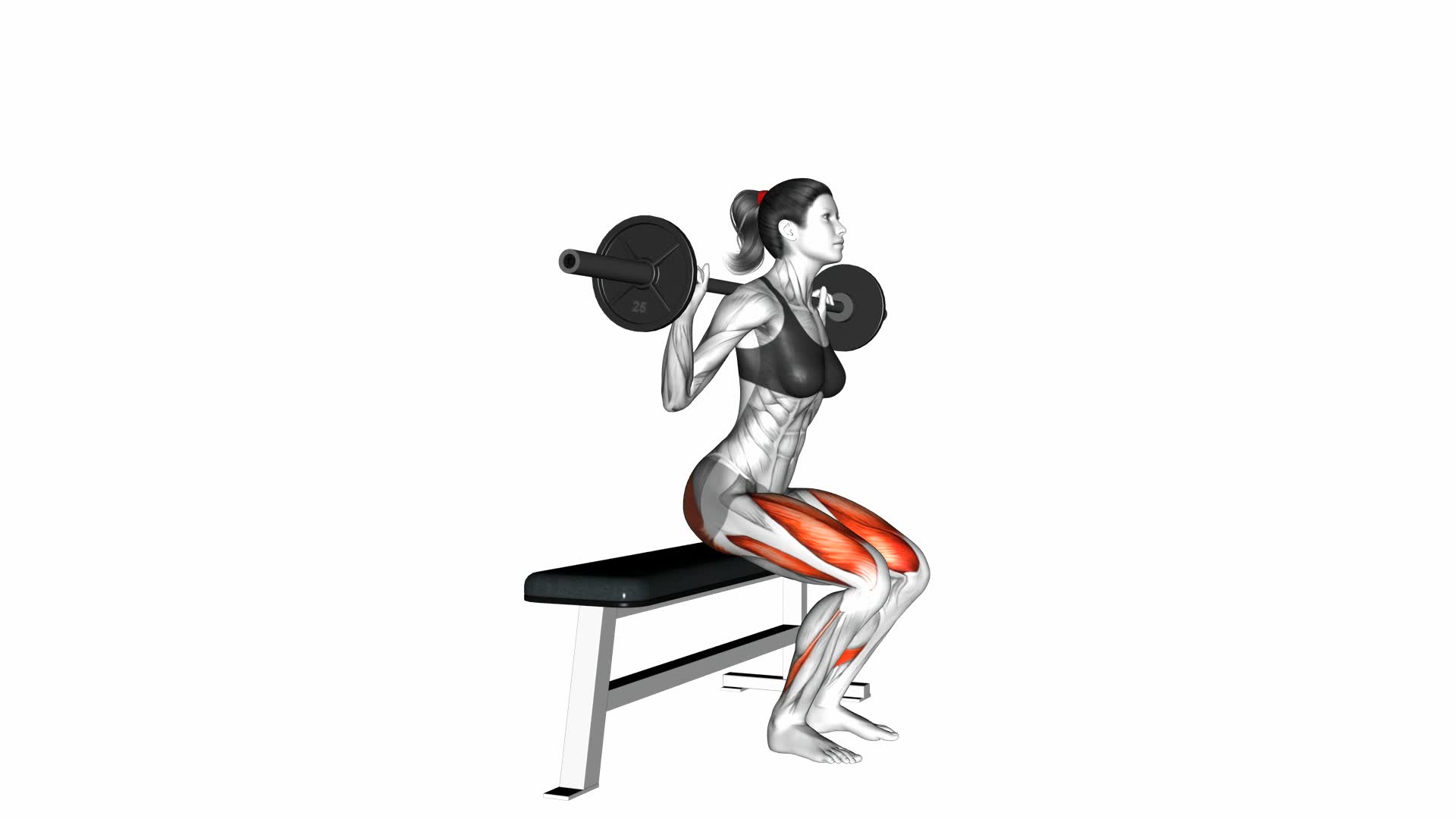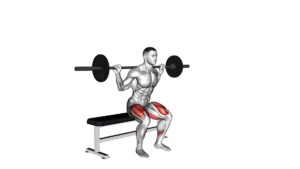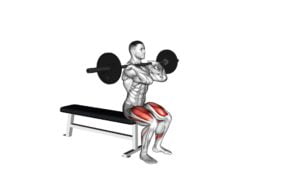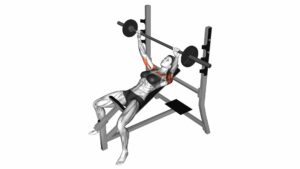Barbell Bench Squat (female) – Video Exercise Guide & Tips

Are you looking to amp up your strength training routine? If so, you'll want to try the barbell bench squat.
Watch This Exercise Video
This exercise is not only effective but also targets your lower body muscles, giving you a killer workout.
In this article, we will guide you through the proper technique, common mistakes to avoid, and tips for increasing the intensity of the barbell bench squat.
Get ready to challenge yourself and see amazing results!
Key Takeaways
- The barbell bench squat is an effective exercise for targeting lower body muscles and improving stability and muscle activation.
- It also targets core, glutes, and back muscles, enhancing overall athletic performance and helping prevent injuries.
- It is important to use proper technique, such as keeping the back straight, knees aligned, and using an appropriate amount of weight.
- To increase the intensity, gradually increase the weight, perform more repetitions, incorporate variations, and consult with a fitness professional for guidance.
Benefits of the Barbell Bench Squat
To maximize your gains, you can experience the benefits of the Barbell Bench Squat by incorporating it into your workout routine. This exercise is highly effective in improving stability and muscle activation.
When performing the Barbell Bench Squat, you aren't only targeting your leg muscles, but also engaging your core, glutes, and back muscles. By utilizing the bench, you're able to maintain proper form and stability throughout the movement. This is crucial for preventing injuries and maximizing the effectiveness of the exercise.
One of the main benefits of the Barbell Bench Squat is its ability to improve stability. As you lower your body down towards the bench, you're challenging your balance and proprioception. This can help you develop stronger stabilizer muscles, which are important for overall strength and injury prevention.
Additionally, the Barbell Bench Squat is known for its high muscle activation. By incorporating this exercise into your routine, you can effectively target your quadriceps, hamstrings, and glutes. This not only helps in building strength and muscle mass, but also enhances your overall athletic performance.
Proper Technique for the Barbell Bench Squat
Mastering the proper technique for the Barbell Bench Squat involves maintaining stability and activating key muscle groups. To perform this exercise, you'll need a barbell and a bench.
Begin by positioning the barbell on the rack at a height that allows you to comfortably reach it while lying on the bench. Lie down on the bench with your feet planted firmly on the floor.
Grab the barbell with an overhand grip, slightly wider than shoulder-width apart. Lift the barbell off the rack and lower it towards your chest, keeping your elbows tucked in.
Once the barbell is close to your chest, push through your feet and extend your legs to lift the weight back up. Make sure to keep your core engaged and your back flat throughout the movement. Avoid arching your back or allowing your knees to cave inwards.
As you gain strength and confidence, you can gradually increase the weight. Remember to always use proper form to prevent injuries.
If the Barbell Bench Squat is too challenging, there are alternative exercises such as dumbbell bench squats or goblet squats that can be done with less weight.
Common Mistakes to Avoid During the Barbell Bench Squat
When performing the Barbell Bench Squat, it's important to be aware of common mistakes to avoid. By being mindful of these errors, you can ensure that you're executing the exercise correctly and maximizing its benefits.
One common mistake to watch out for is rounding your back during the squat. This can put unnecessary strain on your spine and increase the risk of injury. To correct this form, focus on keeping your chest up and your back straight throughout the movement.
Another mistake is allowing your knees to cave inwards as you squat. This can put excessive stress on your knee joints and lead to discomfort or injury. To fix this, concentrate on pushing your knees outwards as you lower down into the squat position.
Additionally, it's important to avoid lifting your heels off the ground during the exercise. This can disrupt your balance and compromise your form. To prevent this, ensure that your weight is evenly distributed through your feet and that your heels remain firmly planted on the ground.
Lastly, be cautious of using too much weight when starting out. It's crucial to gradually increase the load to allow your muscles to adapt and prevent strain or injury.
Tips for Increasing the Intensity of the Barbell Bench Squat
To make the Barbell Bench Squat more challenging, you can increase the weight on the barbell or perform more repetitions. Increasing the difficulty of the exercise will help you build strength and enhance muscle growth.
One way to increase the weight is by gradually adding small increments to the barbell. Start with a weight that feels challenging but manageable, and gradually increase it as you become stronger. This progressive overload will ensure that your muscles continue to adapt and grow.
Additionally, you can perform more repetitions to increase the intensity. Aim to increase the number of reps you do in each set, while maintaining proper form and technique. This will help improve muscular endurance and overall strength.
If you're looking for alternative exercises to further increase the intensity of your workout, you can try incorporating variations of the Barbell Bench Squat. Some options include the Bulgarian Split Squat, the Pistol Squat, or the Barbell Step-Up. These exercises target the same muscle groups as the Barbell Bench Squat but provide a different challenge to your body.
Remember to always consult with a fitness professional before attempting new exercises to ensure proper form and prevent injuries. By continuously challenging yourself and incorporating alternative exercises, you can maximize the benefits of the Barbell Bench Squat and take your strength and fitness to the next level.
Variations and Modifications for the Barbell Bench Squat
If you want to further challenge yourself and add variety to your workout, there are several variations and modifications you can try for the Barbell Bench Squat.
One alternative exercise for lower body strength is the goblet squat. Instead of using a barbell, you hold a dumbbell or kettlebell in front of your chest as you squat down. This variation places more emphasis on your quads and glutes, and it can be a great option if you don't have access to a barbell.
Another modification you can make is the Bulgarian split squat. This exercise targets your quads, glutes, and hamstrings, and it also improves balance and stability. To perform this exercise, place one foot on a bench or step behind you, while the other foot remains planted on the ground. Lower your body down into a squat position, with your back knee coming close to the ground. Repeat on the other side.
To incorporate the barbell bench squat into a full body workout routine, you can pair it with other compound exercises such as the deadlift, overhead press, and bent-over row. This will help you work multiple muscle groups and maximize your overall strength and muscle gains.
Remember to always start with lighter weights and gradually increase the load as you become more comfortable and confident with the exercise.
Frequently Asked Questions
Is the Barbell Bench Squat Suitable for Beginners?
Yes, the barbell bench squat is suitable for beginners.
It's a great exercise for building strength in your lower body.
To perform it with proper form and technique, start by placing the barbell across your shoulders while lying on a bench.
Lower your body until your thighs are parallel to the floor, then push through your heels to return to the starting position.
Common mistakes to avoid include rounding your back and not going low enough.
Can the Barbell Bench Squat Help Improve Lower Body Strength?
Incorporating barbell bench squats into your lower body strength training routine can greatly benefit you. This exercise specifically targets your lower body, helping to improve strength in your legs, glutes, and core.
By using a barbell on the bench, you can challenge your muscles even more, leading to increased muscle growth and overall strength.
How Many Repetitions and Sets Should I Do for the Barbell Bench Squat?
To determine the number of repetitions and sets for the barbell bench squat, consider your fitness level and goals.
For beginners, start with 2-3 sets of 8-12 repetitions with lighter weights.
As you progress, increase the weight and decrease the reps to 6-8.
Advanced lifters can aim for 3-4 sets of 4-6 reps with heavy weights.
Remember to always maintain proper form and technique throughout the exercise, and modify as necessary based on your fitness level.
Can I Use Dumbbells Instead of a Barbell for the Bench Squat?
Yes, you can use dumbbells instead of a barbell for the bench squat. Using dumbbells as an alternative has its own set of benefits.
Dumbbells allow for more freedom of movement and can help improve balance and stability. However, there are also some pros and cons to consider.
Dumbbells may limit the amount of weight you can lift compared to a barbell, but they can also provide a different challenge for your muscles.
Are There Any Alternative Exercises That Target Similar Muscle Groups as the Barbell Bench Squat?
Looking for alternative exercises that target similar muscle groups as the barbell bench squat?
There are a few options you can try. One is the dumbbell bench squat, which allows for a wider range of motion and can help improve stability.
Another option is the goblet squat, which focuses more on the lower body and core.
Both of these exercises provide similar benefits to the barbell bench squat, such as building leg and glute strength.
Give them a try and see which one works best for you!
Conclusion
In conclusion, the barbell bench squat is a highly effective exercise for women that targets the lower body muscles, including the quadriceps, glutes, and hamstrings.
By following proper technique and avoiding common mistakes, you can maximize the benefits of this exercise.
Additionally, incorporating variations and modifications can help increase the intensity and challenge your muscles even further.
So, give the barbell bench squat a try and watch your lower body strength and fitness level soar.

Author
Years ago, the spark of my life’s passion ignited in my mind the moment I stepped into the local gym for the first time. The inaugural bead of perspiration, the initial endeavor, the very first surge of endorphins, and a sense of pride that washed over me post-workout marked the beginning of my deep-seated interest in strength sports, fitness, and sports nutrition. This very curiosity blossomed rapidly into a profound fascination, propelling me to earn a Master’s degree in Physical Education from the Academy of Physical Education in Krakow, followed by a Sports Manager diploma from the Jagiellonian University. My journey of growth led me to gain more specialized qualifications, such as being a certified personal trainer with a focus on sports dietetics, a lifeguard, and an instructor for wellness and corrective gymnastics. Theoretical knowledge paired seamlessly with practical experience, reinforcing my belief that the transformation of individuals under my guidance was also a reflection of my personal growth. This belief holds true even today. Each day, I strive to push the boundaries and explore new realms. These realms gently elevate me to greater heights. The unique combination of passion for my field and the continuous quest for growth fuels my drive to break new ground.







